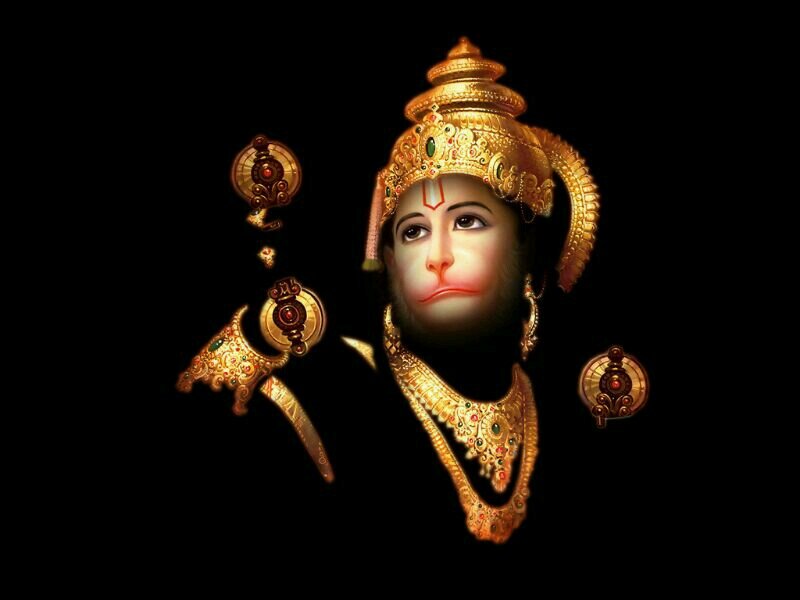Symbolic Significance of Lord Hanuman
Lord Hanuman symbolically stands for pure devotion, complete surrender and absence of ego or the lower self. His character tells us what we can do in our lives by becoming pure devotees of God, aligning ourselves with the forces of good, helping the weak, with self control, unconditional faith and total surrender. As a prominent warrior of the vanara race, he symbolically represents the lower self or the animal (Neanderthal) nature in man, which when refined and transformed becomes stabilized in God and serves the divine cause in total surrender, just as it happened in case of Hanuman.
As the son of Vayu, he symbolically represents the subtle bodies, namely the breath body, the mental body and the intelligence body. The breath body is responsible for the movement of life energy or prana in our bodies. It is especially strong in people who lead ethically clean and celibate lives, performing austerities, for which Anjaneya was particularly famous.

As Vayuputra Hanuman Ji is the breath body in us and can help the lower self (Sita) that is lost to ignorance to reunite with its true companion, the inner soul (Rama). As Veeranjaneya, he is the source of courage and confidence for many a timid heart.
As Bajarangbali, he is strong in both devotion and physical strength. He is an ocean of virtues and friend of the pure hearted. He loves the ascetic qualities in man because only those who are detached and mentally free from the luxuries of life and desires of their bodies can truly concentrate on the divine and attain Him.

In the macrocosm Rama represents the Supreme Self and Hanuman as his devotee, the individual Self. Within in the microcosm of the embodied Self (jiva), Rama represents the embodied Self, who is caught in the cycle of births and deaths (Samsara). Sita represents the physical Self or mind and the body complex (Kshetra). Ravana with his ten heads represents the ego with ten senses which have fallen into evil ways.
Hanuman represents, the breath. When ego and the senses carry away the mind and body and put them to wrong use, with the help of breath the embodied soul restrains the senses, silences the ego, regains the control of the mind and body and stabilizes them in the contemplation of God.
Thus, Hanuman represents many things at many levels. He is regarded as the Superman, the perfect man, the knowledge body (gnana guna sagara) in man, the immortal man (chiranjeevi), the animal man and the flying human (va+nara).!
Other names of Hanuman: Mahavir, Maruti, Pawan-suta, anjaneya, ram-doot, Rama-das, Kesari-nandan and many more.
Other forms of Hanuman: Sometimes hanuman is shown flying with one hand holding up a mountain; He is shown opening his chest with His own hands and showing Rama and Sita sitting in His heart.
Significance: Hanuman is one of the most popular Hindu deities. He is an embodiment of service (Seva), devotion (Bhakti) and surrender (samarpan, egolessness). He is an incarnation of shiva. He is also considered the son of wind-god (Maruta) son of Anjani Devi. He has a high chin (hence the name Hanuman) and a long tail like that of monkey. In physical characteristics he looks sub-human, but his qualities are divine/super human, which all of us aspire to have. He is endowed with tremendous physical and spiritual strength, courage and valor (hence the name mahavir), fearlessness, devotion to Rama and sita, (hence the name Rama-das, Rama-doot etc.) high intelligence, truthful speech, ocean of knowledge and other good qualities. He is in complete control of all his senses.
Hanuman is worshipped by all especially those who are engaged in games and sports and those who are engaged in hard yogic practices.
Hanuman carrying a mountain in his hand shows his tremendous devotion to carry out the task given by his master, Lord Rama. Opening his chest to show there is nothing other than Rama and Sita in His heart shows that He is totally surrendered to his lord (egoless). His very humble pose in Rama-darbar shows that he is a servant of Rama; this represents a calm, controlled and concentrated mind surrendered to truth, which is otherwise restless like a monkey. Like hanuman, we should strive to serve our lord (our true self, Atman), by bringing our mind, buddhi under the control of our own soul.
As son of wind-god (Marut) he symbolizes the power of breath (Pranayama), since breath and mind are directly connected. His success in location and contacting Sita(pure Buddhi) in the forest, means it is the calm and controlled mind that can discover our inner hidden (or imprisoned) potential.
Essence of Hanuman chalisa, the famous forty verses which are recited by millions of hindus everyday, give a very good description (Summary) of the qualities and deeds of hanuman in the Ramayana and it’s chanting will remind us to achieve great qualities of:
- Physical, mental, emotional and spiritual strengths
- Vast knowledge (Gyaan Gun Sagar), super, intellect (Vidya)
- Humility, service to Ram (Soul).
- Fearless, Selflesseness, egoless with attitude- nothing is impossible.
Jai Shri Ram ~ Jai Rudra ke Roop Hanuman! 🙏🙏



